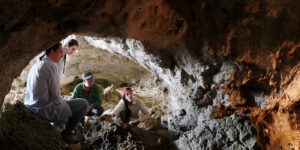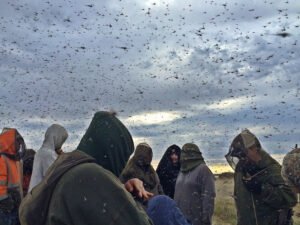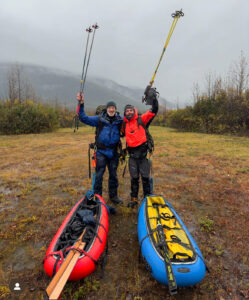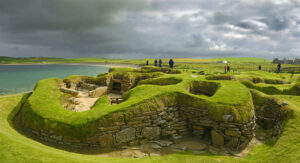Last month, I visited Beechey Island in the Canadian High Arctic for the umpteenth time. Barren and hostile, Beechey is nevertheless the most visited historic site in the Arctic. Twin Otter airplanes from the nearby hamlet of Resolute Bay have landed on the flat beach with day visitors for decades. And every arctic cruise ship, a couple of dozen of them each summer, stops here.
Why the interest? Because Sir John Franklin and his men spent their first winter in this sheltered harbor in 1845-46, before heading further west in search of the Northwest Passage, ultimately to their doom.
Three of Franklin’s men didn’t even make it through that first winter. They died of tuberculosis or pneumonia and were buried on the gravel beach. A few years later, one of the sailors searching for Franklin also died here and was buried beside them. The original wooden grave markers were taken to a museum, but replica markers indicate who is buried in which grave.
Oddly, though, there seems to be a fifth, unmarked grave beside the original four. Visitors are always curious. Who is that?
It turns out that these are the remains of a wealthy individual who at least 50 years ago, decided to have himself buried at this historic site, beside Franklin’s men. There was no law against it then, and there seems to be no law against it now. Why have yourself buried in an ordinary graveyard when you can achieve a measure of posthumous notoriety by making yourself part of a story that you have nothing to do with?

The fifth grave. Photo: Jerry Kobalenko

Cruise staff explain the Beechey site to passengers. The unmarked fifth grave is at the far right. Photo: Jerry Kobalenko
Graffiti Row
Beechey is a haunted, fascinating spot, but it is also a mess of such vanity gestures. Two other people, a territorial administrator and a scientist, are buried a little further down the beach. They lie just above the ruins of Northumberland House, built in 1852-3 by one of the parties searching for Franklin. They are in what I like to call Graffiti Row.

The ruins of Northumberland House, with Graffiti Row above. Photo: Jerry Kobalenko

Photo: Jerry Kobalenko

Photo: Jerry Kobalenko
Some are legitimate memorials from that era. A cenotaph stands in honor of explorer Joseph-Rene Bellot, who died nearby. Lady Franklin herself provided the marble slab underneath the cenotaph, and the cross is built of discarded cans from the Franklin expedition. Behind the cenotaph, Captain Joseph-Elzear Bernier etched his name on a piece of wood in 1906, during his project to assert Canadian sovereignty across the arctic islands.

The cenotaph to Joseph-Rene Bellot. Photo: Jerry Kobalenko
‘I was here’
Other cairns and memorials are totally irrelevant. Europeans transiting the Northwest Passage in sailboats, in particular, seem to behave toward the Arctic as if it’s still the nineteenth century. A Hungarian family that sailed the Northwest Passage eight years ago left their name bolted to a rock beside a cairn. Several “time capsules” also litter the ground around the cairn.
Just up from the graves, some modern French yachties built a second cairn and laid a plaque to Bellot. Typically, the plaque included their own names in bronze. Because that’s the point: On the pretext of commemorating some valid past explorer, they’re really commemorating themselves. “I was here.”


Graffiti from two European parties who navigated the Northwest Passage in their sailboats. Photo: Jerry Kobalenko
Vanity plaques at other sites
Beechey is not the only place that suffers from this sort of graffiti. Norwegians are amazing arctic explorers who have accomplished some of the most difficult polar journeys of modern times. But this was not one of them: In 1992, a Norwegian hired Inuit guides to snowmobile him hundreds of kilometers on Ellesmere Island. He came from the same hometown as Otto Sverdrup — Steinkjer. Sverdrup’s presence dominates Ellesmere, and at key Sverdrup sites, the Norwegian tourist bolted elaborate plaques on boulders, commemorating Sverdrup and himself in equal point size.

Photo: Jerry Kobalenko
I’ve unbolted one of these plaques and thrown it in the ocean. Another now serves as a hot plate stand in my kitchen. More remain out there. They’ll last 1,000 years, or 10,000 years, in that environment. It is important to get to them in time because after 50 years, they themselves technically become artifacts and should not be touched.
Even this summer, adventurers continued this practice. The UK rowers who had attempted the Northwest Passage stopped for a couple of days at the historic Hudson Bay post at Fort Ross, at the eastern mouth of Bellot Strait. They shouldn’t even have been there; you need a permit to land at Fort Ross, and none were being granted this summer. It’s likely that they didn’t know permission was necessary. But they too left a plaque behind, largely celebrating themselves. “We were here.”

Photo: Facebook
Back in the 1970s, when those people had themselves buried on Beechey Island, these gestures were partly understandable. It was a different era. At that time, even scientists sometimes took artifacts home as souvenirs. That is obviously not acceptable today. Nor should commemorating your own minor journeys with long-lasting plaques, even if you’re doing so partly to pay tribute to a hero of yours. In most ways, the Arctic remains as wild as it was in the nineteenth century. But this is not the nineteenth century.






